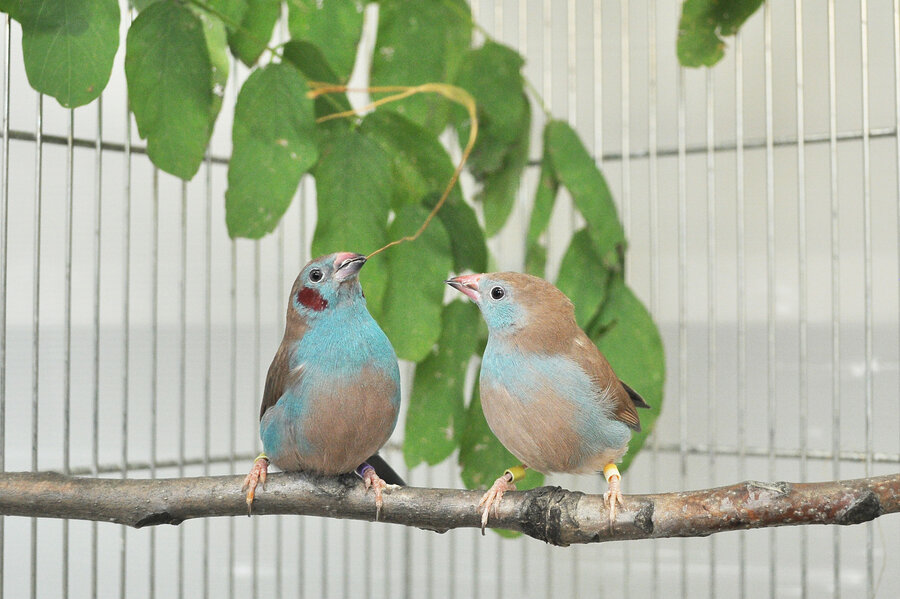Some birds 'tap dance' to woo potential mates, say scientists
Loading...
To woo mates, birds might sing songs or ruffle their feathers. But that's not all they might try.
Scientists captured video of blue-capped cordon-bleu songbirds, socially monogamous birds native to Africa, performing complex, rhythmic courtship dances.
The songbird forms a sort of one-man-band, combining percussive dance steps and melodic tweets to serenade a potential mate. The researchers describe the cordon-bleu's tap dancing, as they call it it, in a new paper published Thursday in Scientific Reports.
"They show very quick steps and make sounds by such steps. They perform tap dance to impress potential mates," study author Masayo Soma, an ornithologist at Hokkaido University in Japan, explains in an email to The Christian Science Monitor.
The cordon-bleu's dance steps are so quick that, to the naked eye, they just look like hops or bobs. But the researchers were able to take a closer look by slowing down film they captured.
As you can see in the video clips, says Dr. Soma, "they move both feet up and down alternately, which might look more similar to the foot movements of flamenco dancers than to tap dancers."
The birds hop into the air, performing up to 6 steps at a time.
"What we know is that the number of steps decreases while they are singing, which can be interpreted as that they avoid interference between singing and step sounds, or that it is too physically demanding to sing and perform many-step dancing simultaneously," Soma says.
The researchers aren't quite sure what in a bird's dancing particularly attracts a mate.
"One possibility is that cordon-bleus are looking for best tap-dance performers, but according to our observation, there was no tendency that particular male or female with more number of steps was popular among the other sex," says Soma. "So, we are puzzled."
The researchers "predict that the number of the steps included in one hopping (or bobbing) might be important to show their ‘vigor’ or physical quality," says Soma.
"But there might be other factors that contribute to mate choice, which we need to look at in the future studies," she says
A balanced duet
The male cordon-bleu isn't performing this song and dance alone. Both sexes engage in a sort of courtship duet, each performing their own show to woo a partner.
Researchers have previously focused their attention on males' courtship behaviors, assuming that females were in charge of mate selection.
"Often the females are ignored in these displays," ornithologist at the Cornell Lab of Ornithology Anastasia H. Dalziell, who wasn't involved in the study, tells the Monitor in an interview. "We don't even give them a second glance," she says of researchers' attention to the females. This research shows that "we really should be paying more attention to what the females are doing in these duets."
How unique is this percussive duet?
Hints of such mutual mate choice has appeared in other birds such as storks, albatrosses, and some seagulls, says Dr. Dalziell. But there has been less evidence of mutual selection among songbirds.
Dancing might not be unique to the cordon-bleus, but their tap dancing does stand out.
"Many related species (Estrildid finches) show some dance, which typically include hopping and singing, but none of the species that we observed so far showed rapid stepping," says Soma. "Some other species, such as blue-footed boobies show stepping dance, but their steps are much slower and probably make no conspicuous sounds."
A hint of humanity in the love birds
Courtship may look different across species, but the songbirds might be more like us than they seem.
"Humans' way of courting might be different from that of our birds, but I believe that courting behaviors of birds have many parallels with human music and dance, and can give us a hint of biological meaning of them," says Soma.
Dalziell agrees. "We often find that we define ourselves, as humans, as different in some way from other animals," she says "But often we look at other animals and from our data we realize that we have a lot more in common with other species than we first realized."
This newfound tap-dancing duet is a fun surprise, says Dalziell. And that might just mean more interesting discoveries in the natural world to come.
"The more we look at it," she says of the natural world, "the more we discover that we may think that we know a lot, but in fact there's a lot out there to be discovered."
"We live in this extraordinary world and we still have all these surprises coming at us," Dalziell says.








